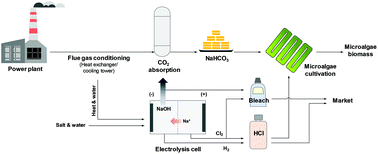The use of bicarbonate for microalgae cultivation and its carbon footprint analysis†
Abstract
There have been many difficulties in supplying CO2 for the mass production of microalgae, which are regarded as a sustainable source of various bio-materials and biofuels. Bicarbonate-based microalgae cultivation may offer an alternative way, circumventing the exceedingly large energy demands for gas compression and the low carbon utilization efficiency of the conventional CO2-based cultivation. To realize this bicarbonate-based approach, this study first demonstrated the ability of nine microalgae to utilize bicarbonate as a carbon source and determined their optimal culture conditions with bicarbonate, such as bicarbonate concentration, temperature, and light intensity. Furthermore, to make this bicarbonate-based cultivation practical, this study proposed a potential novel combination of microalgae cultivation and electrochemical CO2 mineralization process, which can provide sodium bicarbonate (NaHCO3) from flue gas in an eco-friendly manner. Besides, potential benefits of using NaHCO3 as a carbon source were assessed via carbon footprint analysis from the perspective of the entire process, ranging from carbon source preparation to microalgae cultivation. This analysis, though rough in nature, revealed that bicarbonate can be more advantageous than raw flue gas or monoethanolamine (MEA)-extracted pure CO2 with respect to net CO2 emissions and algal biomass productivity. These benefits were even more pronounced when the transport of carbon sources was considered. A low carbon outgassing rate of maximum 9.6 ppm day−1 and a substantially high carbon utilization efficiency of >86.7% with bicarbonate were found to be the determining factors. All these supported that the bicarbonate-based cultivation of microalgae is indeed feasible and practical, in particular when integrated with the electrochemical CO2 mineralization technology.



 Please wait while we load your content...
Please wait while we load your content...